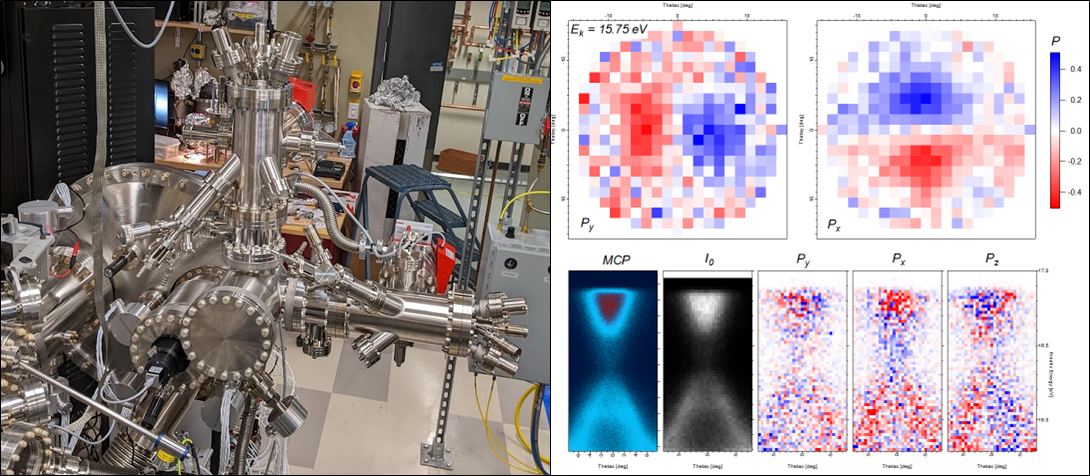Angle-resolved photoemission spectroscopy

Angle-Resolved Photoemission Spectroscopy (ARPES) is the premiere experimental tool for directly accessing electronic structure in quantum materials. The unique integrated design of the PARADIM ARPES system in combination with the versatile synthesis capability of the molecular beam epitaxy (MBE) tool allows for unprecedented access to bandstructure measurements across the huge diversity of materials available for growth by MBE.
The PARADIM ARPES system is built around a custom-designed magnetically shielded Ultra-High Vacuum analysis chamber with a typical operating pressure of 5E-11 Torr. For measurement, films are attached to a three-stage, 6-axis closed-cycle cryomanipulator with base temperature of 5 K. Ultraviolet photons are provided from a next-generation high-flux multi-gas RF plasma lamp with an overall intensity ~5x greater than that of convention microwave sources for standard He-Iα emission. In addition, the plasma lamp can be operated with different gases, allowing selectable photon energies of 40.8 eV (He-II), 21.2 eV(He-Iα), 16.8 eV (Ne), 10 eV (Kr), or 8.4 eV (Xe). Data is collected using a state-of-the art high-resolution Scienta DA-30L electron analyzer with an ultimate energy resolution better than 2 meV. Finally, custom-written control and analysis software allows for safe, easy operation of the system and rapid spectral analysis even for inexperienced ARPES users.
The PARADIM ARPES DA30-L electron analyzer is equipped with a pair of VLEED spin polarimeters based on the spin exchange scattering mechanism, which is ~50x more eficcient than the Mott detection schemes used in previous-generation systems. Combined with the DA-30L electron deflection optics, this rare, state-of the art capability allows for 3D (in and out-of-plane) spin resolved ARPES measurements within the entire acceptance cone of the analyzer without changing sample geometry.
This capability enables direct visualization of the spin texture of electronic states in momentum space for quantum materials grown by MBE
In addition, the analysis chamber is equipped with an Omicron DSX400 X-ray source for chemical analysis via x-ray photoelectron spectroscopy (XPS), as well as a low-energy electron diffraction (LEED) system for structural analysis which can all be performed in-situ in conjunction with ARPES and MBE.
Sample Publications Using this Instrument
C.T. Parzyck, A. Galdi, J.K. Nangoi, W.J.I. DeBenedetti, J. Balajka, B.D. Faeth, H. Paik, C. Hu, T.A. Arias, M.A. Hines, D.G. Schlom, K.M. Shen, and J.M. Maxson, "A Single-Crystal Alkali Antimonide Photocathode: High Efficiency in the Ultra-Thin Limit," Phys, Rev. Lett. 128, 114801 (2022).
J.N. Nelson, N.J. Schreiber, A.B. Georgescu, B.H. Goodge, B.D. Faeth, C.T. Parzyck, C. Zeledon, L.F. Kourkoutis, A.J. Millis, A. Georges, D.G. Schlom, and K.M. Shen, "Interfacial Charge Transfer and Persistent Metallicity of Ultrathin SrIrO3/SrRuO3 Heterostructures," Sci. Adv. 8, abj0481 (2022).
B.D. Faeth, S.-L. Yang, J.K. Kawasaki, J.N. Nelson, P. Mishra, C.T. Parzyck, C. Li, D.G. Schlom, and K.M. Shen, "Incoherent Cooper Pairing and Pseudogap Behavior in Single-Layer FeSe/SrTiO3," Phys. Rev. X 11, 021054 (2021) and Highlight #43.
J.P. Ruf, H. Paik, N.J. Schreiber, H.P. Nair, L. Miao, J.K. Kawasaki, J.N. Nelson, B.D. Faeth, Y. Lee, B.H. Goodge, B. Pamuk, C.J. Fennie, L.F. Kourkoutis, D.G. Schlom, and K.M. Shen, “Strain-Stabilized Superconductivity,” Nat. Commun. 12, 59 (2021) and Highlight #36.
Y. Ma, A. Edgeton, H. Paik, B. Faeth, C. Parzyck, B. Pamuk, S.-L. Shang, Z.-K. Liu, K.M. Shen, D.G. Schlom, and C.-B. Eom, “Realization of Epitaxial Thin Films of the Topological Crystalline Insulator Sr3SnO,” Adv. Mater. 32, 2000809 (2020) and Highlight #28.







